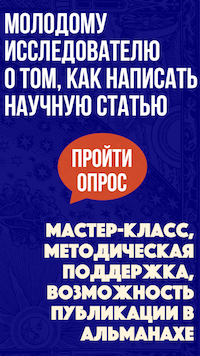МОЛОДЁЖНЫЙ ПРОЕКТ ДЛЯ ТЕХ, КТО ДЕЛАЕТ ПЕРВЫЕ ШАГИ В НАУКЕ
/components/bitrix/system.auth.form/auth_alm/images/login.gif) Войти
Войти /components/bitrix/system.auth.form/auth_alm/images/register.gif) Регистрация
Регистрация
Войти в корпоративную почту как автор/член редколлегии/рецензент журнала




СИМВОЛ ЭПОХИ: ЛЮДИ, КНИГИ, СОБЫТИЯ SYMBOL OF THE EPOCH: PERSONS, BOOKS, EVENTS / DAS SYMBOL DER EPOCHE: PERSONEN, BÜCHER, VERANSTALTUNGEN
Н.В. Гоголь и В.Г. Белинский: поверх стереотипов
Литература
Белинский В.Г. «Вся жизнь моя в письмах». Из переписки В.Г.Белинского / Сост. И.Р. Монахова. М.: Грифон, 2011.
Белинский В.Г. Полн. собр. соч.: В 13 т. Т. 10. М.: Изд-во АН СССР, 1956.а.
Белинский В.Г. Полн. собр. соч.: В 13 т. Т. 11. М.: Изд-во АН СССР, 1956.б.
Богаевская К. Письмо Белинского к Гоголю: история создания письма к гоголю и его первые слушатели, — первое распространение списков письма в 1848-1849 гг. — происхождение списка письма из бумаг Н.Ф. Павлова (1853 г.) — история первой публикации письма в «Полярной звезде» 1855 г. — обзор публикации письма,- проблема установления научно-проверенного текста письма // Литературное наследство. 1950. Т. 56. С. 513—605.
Герцен А. Соч.: В 2 т. Т. 2. М.: Мысль, 1986.
Гоголь Н.В. Выбранные места из переписки с друзьями // Собр. соч.: В 7 т. Т. 6. М.: Худож. лит., 1986. С. 173—369.
Достоевский Ф.М. Бесы // Полн. собр. соч.: В 30 т. Т. X. Л.: Наука, 1974.
Достоевский Ф.М. Дневник писателя. 1873 // Полн. собр. соч.: В 30 т. Т. XXI. Л.: Наука, 1980.
Зеньковский В.В. Н.В. Гоголь // Русские мыслители и Европа. М.: Республика, 1997. C. 110—141.
Ларинский Н.Е. «Итак, что касается до меня, всё хорошо…». История болезни В. Г. Белинского [Электронный ресурс] // UZRF.ru: Портал учреждений здравоохранения Российской Федерации. 2016. 29 авг. Режим доступа: http://uzrf.ru/publications/istoriya_i_bolezni/nikolay_larinskii_belinskii/.
Мелехов Д.Е. Психиатрия и проблемы духовной жизни // Психиатрия и актуальные проблемы духовной жизни. М.: Свято-Филаретовская московская высшая православно-христианская школа, 1997. С. 34—62.
Мочульский К. Духовный путь Гоголя // Русская идея: В кругу писателей и мыслителей Русского Зарубежья: В 2 т. / Сост. В.М. Пискунов. Т. 2. М.: Искусство, 1994. С. 450—464.
Розанов В.В. Гоголевские дни в Москве // Гоголь в русской критике: Антология / Сост. С.Г. Бочаров. М.: Фортуна ЭЛ, 2008.а. С. 278—286.
Розанов В.В. Из «Уединенного» и «Опавших листьев» // Гоголь в русской критике: Антология / Сост. С.Г. Бочаров. М.: Фортуна ЭЛ, 2008.б. С. 304—313.
Розанов В.В. Как произошел тип Акакия Акакиевича // Гоголь в русской критике: Антология / Сост. С.Г. Бочаров. М.: Фортуна ЭЛ, 2008с. С. 182—192.
Тихонова Е.Ю. Человек без маски. Личность В.Г. Белинского в его переписке. М.: Эдиториал УРСС, 2002.
Флоровский Г. Христианство и цивилизация // Избранные богословские статьи. М.: , 2000. С. 218—227.
Epstein M. "The Demise of the First Secularization: The Church of Gogol and the Church of Belinsky." Studies in East European Thought 58.2 (2006): 95—105.
Terras V. "A Christian Revolution in Russian Literary Criticism." The Slavic and East European Journal 46.4 (2002): 769—776.
References: Belinsky V.G. "All My Life in Letters”. From Vissarion Belinsky’s Correspondence. Ed. I.R. Monakhova. Moscow: Grifon Publisher, 2011. (In Russian).
Belinsky V.G. Complete Works. Moscow: USSR Academy of Sciences Publisher, 1956, volume 10. (In Russian).
Belinsky V.G. Complete Works. Moscow: USSR Academy of Sciences Publisher, 1956, volume 11. (In Russian).
Bogayevskaya K. "Belinsky’s Letter to Gogol." Literary Heritage 56 (1950): 513—605. (In Russian).
Dostoevsky F.M. Collected Writings, Volume X: The Devils. Leningrad: Nauka Publisher, 1974. (In Russian).
Dostoevsky F.M. Collected Writings, Volume XXI: The Diary of Writer. 1873. Leningrad: Nauka Publisher, 1980. (In Russian).
Epstein M. "The Demise of the First Secularization: The Church of Gogol and the Church of Belinsky." Studies in East European Thought 58.2 (2006): 95—105.
Florovsky G.V. "Christianity and Civilization." Selected Theological Articles. Moscow: Probel Publisher, 1998. 386—393. (In Russian).
Gogol N.V. "Selected Passages from Correspondence with Friends." Collected Writings. Moscow: Khudozhestvennaya literatura Publisher, 1986, volume 6. 173—369. (In Russian).
Herzen A.I. Writings. Moscow: Mysl Publisher, 1986, volume 2. (In Russian).
Larinsky N.E. "‘So, As For Me, Everything Is Fine...’. Vissarion Belinsky's Case Clinical History." UZRF.ru: Portal of Health Care Institutions of the Russian Federation. 2016. Aug 29 Web Melekhov D.E. "Psychiatry and Problems of Spiritual Life." Psychiatry and Actual Problems of Spiritual Life. Moscow: St. Philaret Moscow Orthodox-Christian Institute Publisher, 1997. 34—62. (In Russian).
Mochulsky K. "Gogol‘s Spiritual Path." Russian Idea: In the Circle of Writers and Thinkers of Russian Abroad. Ed. V.M. Piskunov. Moscow: Iskusstvo Publisher, 1994, volume 2. 450—464. (In Russian).
Rozanov V.V. "Gogol’s Days in Moscow.". Gogol in Russian Critic. Ed. S.G. Bocharov. Moscow, Fortuna EL Publisher, 2008. 278—286. (In Russian).
Rozanov V.V. "From ‘Solitaria’ and ‘Fallen Leaves’." Gogol in Russian Critic. Ed. S.G. Bocharov. Moscow, Fortuna EL Publisher, 2008. 304—313. (In Russian).
Rozanov V.V. "How the Type of Akaky Akakievich Appeared." Gogol in Russian Critic. Ed. S.G. Bocharov. Moscow: Fortuna EL Publisher, 2008. 182—192. (In Russian).
Terras V. "A Christian Revolution in Russian Literary Criticism." The Slavic and East European Journal 46.4 (2002): 769—776.
Tikhonova E.Yu. Person Without Mask. Vissarion Belinsky’s Personality in His Correspondence. Moscow: Editorial URSS Publisher, 2002. (In Russian).
Zenkovsky V.V. "Nikolai Gogol." Russian Thinkers and Europe. Moscow: Respublika Publisher, 1997. 10—141. (In Russian).












